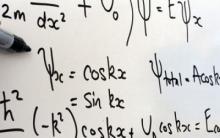Provides rigorous training supported by research assistantships, teaching assistantships and fellowships.
The Department of Physics, Applied Physics, and Astronomy prepares students to contribute to new concepts and technologies through innovative teaching methods that combine student-faculty interactions, computer-based education, and “hands-on” experience in modern laboratories.
Plan of Study
Completion of the M.S. requires 30 credits of graduate work, including a minimum of 21 credits in course work.
Course work should meet the needs of the individual student, but must include PHYS 6510 and two of the following three courses: PHYS 6410, PHYS 6520, and PHYS 6590.
The master’s degree also requires some credits of research, which may culminate in a formally presented thesis (6 to 9 credits) or a research project (3 to 6 credits).
Students who successfully complete this program will be able to:
- demonstrate mastery of core graduate-level Physics through completion of a selection of graduate courses including Quantum Mechanics, Electrodynamics, and Statistical Physics.
- demonstrate mastery of a modern sub-topic in physics, such as astrophysics, particle physics, condensed matter, or computational physics through coursework and completion of a project or thesis.
- clearly communicate their ideas and results to general and specialized audiences, both orally and in writing.
Facilities
Ever since its inception, Rensselaer has been a leader in science and technology education. Today, the institute provides students with one of the most modern environments for learning.
Students’ thesis research in astronomy and astrophysics enjoys access to world-class ground-based telescopes located at observing sites in the southern hemisphere and China. Our faculty cooperates with the international Large Sky Area Multi-Object Fiber Spectroscopic Telescope (LAMOST), the Sloan Digital Sky Survey, and the very popular MilkyWay@Home project.
For students’ education in observational astronomy and for public outreach, the department maintains the Hirsch Observatory. It houses a fully automated Boller and Chivens 16" Cassegrain Telescope, a Quantum Scientific Imaging (QSI) imaging camera with filter wheel, and a Santa Barbara Instrument Group (SBIG) spectrograph. Many smaller telescopes are also available to students.
State-of-the art equipment for graduate students’ experimental research in optics and condensed matter physics is provided in the physics department. The equipment includes optical, electronic, and cryogenic instruments, surface science techniques and materials growth equipment. Examples are Atomic Force Microscopy, Auger Electron Spectroscopy, Ellipsometry, High-Resolution Low Energy Electron Diffraction, Reflection High-Energy Electron Diffraction, X-Ray Crystallography, and Super-Resolution Microscopy. Also available for research are terahertz radiation sources and ultrafast laser systems. Students engage in absorption, light scattering, and photoluminescence spectroscopy using systems operating from the terahertz frequency band to the ultraviolet part of the electromagnetic spectrum.
Students interested in nanofabrication will find excellent facilities in Rensselaer’s Micro and Nano-Fabrication Clean Room (MNCR). This is a state-of-the-art, 5,700-square-foot, Class 100 multi-user facility which supports research and education in nanotechnology, biotechnology, microelectronics, solid state lighting, energy, and other fields. The MNCR offers infrastructure for end-to-end device fabrication, characterization, metrology and testing by the graduate student user on substrates ranging from a few millimeters in size to full wafers 200 mm in diameter for high-speed electronics, power devices, integrated circuits, microsystems, and other applications. Fabrication of structures as small as 20 nm is possible in the MNCR, and structures as small as 1.5 nm can be achieved. In addition, the facility has several dedicated staff members to provide process solutions, training, and teaching.
The Center for Biotechnology and Interdisciplinary Research on our campus offers extensive and high-quality facilities for students’ experimental research in biological physics at the molecular, cellular and tissue level.
Students conducting research in theoretical condensed matter physics use Rensselaer’s own supercomputer. The Blue Gene/Q is one of the world’s most powerful university-based supercomputers. Theoretical methods implemented by our students on this machine and other computers are density functional theory calculations, Monte-Carlo Simulations as well as classical and quantum mechanical molecular dynamics simulation.
In addition, the Department’s research activities are affiliated with numerous research centers on campus: The Center for Computational Innovations, the Center for Future Energy Systems, the Center for Materials, Devices and Integrated Systems, the Network Science and Technology Center, the Institute for Data Exploration and Applications, the Rensselaer Nanotechnology Center, the Scientific Computation Research Center, the Smart Lighting Engineering Research Center, and the Data Science Research Center.
Rensselaer research in particle astrophysics is involved in one of the leading experiments that could detect neutrinoless double beta decay, the nEXO experiment at SNOLAB in Canada.
Students pursuing thesis research in theoretical particle physics apply lattice field theories and implement the calculations on the Blue Gene/Q supercomputer.
Documents and Resources
Academic Opportunities

Our faculty and students' scholarly achievements are reflected by the awards they have received from a variety of organizations.
